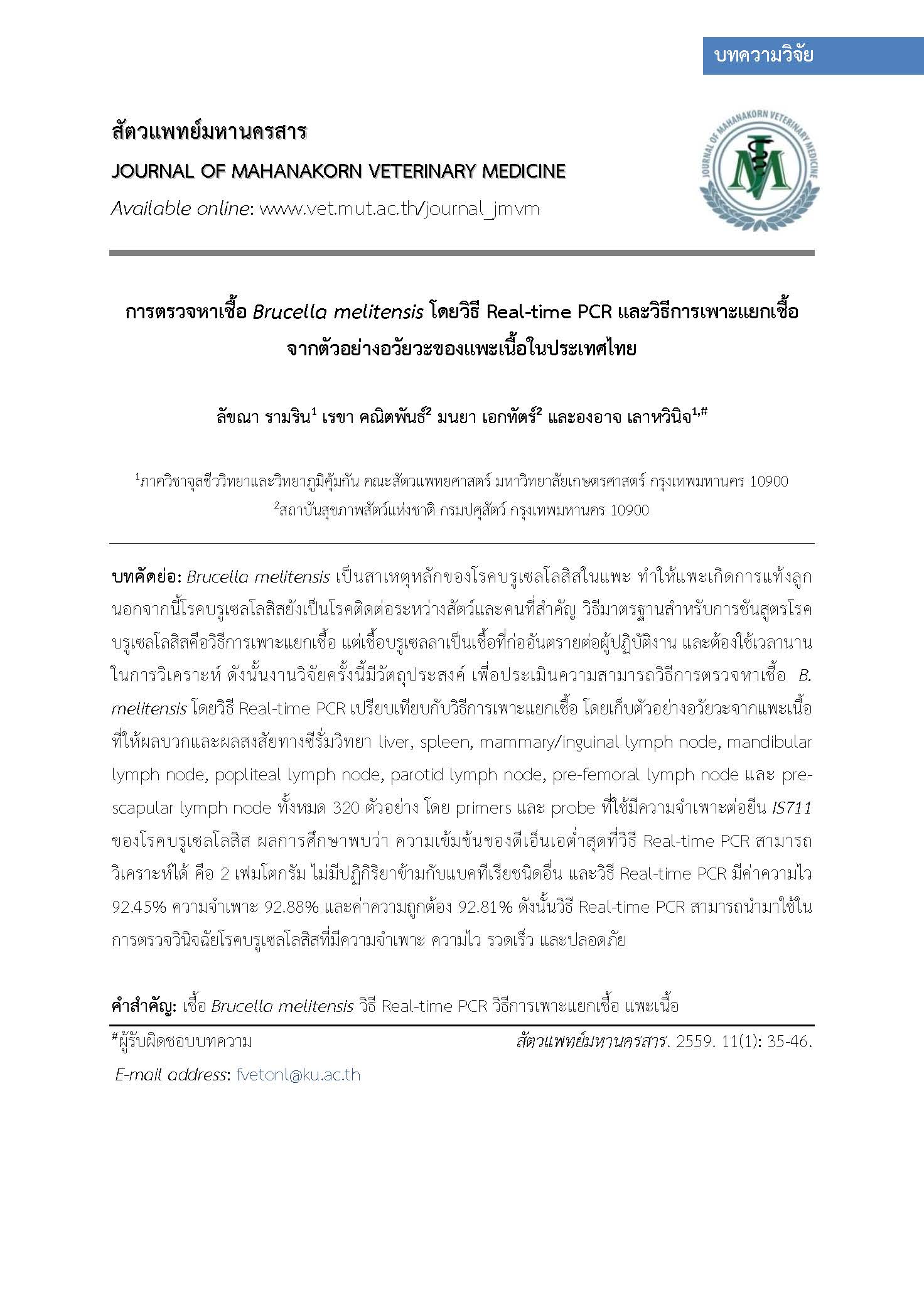Detection of Brucella melitensis Using Real-time PCR and Isolation from Organs of Meat Goat in Thailand
Main Article Content
Abstract
Brucella melitensis is the most prevalent causative agent of goat brucellosis: one of the most important zoonotic diseases related to the reproductive losses and abortion. Conventional culture method is considered the gold standard for brucellosis diagnosis. However, this method is hazardous, labor-intensive and time-consuming. Therefore, the present study aims to evaluate an efficiency of Real-time PCR diagnosis method: the more convenient and less time consuming method by comparing to culture method. Total 320 samples of liver, spleen, mammary/inguinal lymph node, mandibular lymph node, popliteal lymph node, parotid lymph node, pre-femoral lymph node and pre-scapular lymph node were collected from seropositive and suspicious meat goats. Primer and probe specific for the insertion sequence (IS711) gene of B. melitensis were used. The limit of detection (LoD) of Real-time PCR assay is 2 femtogram (fg) with no cross reactions with other 20 related pathogens. Compared to the gold standard method, Real-time PCR assay contains 92.45% sensitivity, 92.88% specificity and 92.81% accuracy. In conclusion, Real-time PCR assay is sensitivity and specificity method for the rapid and safe detection of brucellosis diagnosis.
Article Details
References
Alton, G.G., Jones, L.M. and Pietz, D.E. 1975. Laboratory techniques in brucellosis, second ed. Monograph Series No. 55 World Health Organisation, Geneva.
Blasco, J.M. 1992. Diagnosis of Brucella melitensis infection in small ruminants. In: Plommet, M. (Ed.), Prevention of Brucellosis in the Mediterranean Countries. Puduc Scientific Publishers, Wageningen, The Netherlands. 272-278.
Blood, D.C. and Henderson, J.A. 1968. Veterinary medicine. Bailliere Tindal Cassel Ltd. London, England.
Bogdanovich, T., Skurnik, M., Lubeck, P.S., Ahrens, P. and Hoorfar, J. 2004. Validated 5’ Nuclease PCR Assay for Rapid Identifidation of the Genus Brucella. J. Clin. Microbiol. 42: 2261-2263.
Bounaadja, L., Albert, D., Chenais, B., Henault, S., Zygmunt, M.S., Poliak, S. and Garin-Bastuji, B. 2009. Real-time PCR for identification of Brucella spp.: A comparative study of IS711, bcsp31 and per target genes. Vet. Microbiol. 137:156-164.
Bricker, B.J. 2002. PCR as a diagnostic tool for brucellosis. Vet. Microbiol. 90: 435-446.
Godfroid, J., Cloeckaert, A., Liautard, J.P., Kohler, S., Fretin, D., Walravens, K., Garin-Bastuji, B. and Letesson, J.J. 2005. From the discovery of the Malta fever’s agent to the discovery of a marine mammal reservoir, brucellosis has continuously been a re-emerging zoonosis. Vet. Res. 36: 313-326.
Hinic, V., Brodard, I., Thomann, A., Holub, M., Miserez, R. and Abril, C. 2009. IS711-based real-time PCR assay as a tool for detection of Brucella spp. in wild boars and comparison with bacterial isolation and serology. BMC Vet. Res. 5:22.
Kanitpun, R., Ekgatat, M., Thammasart, S. and Nokdhes, C. 2006. Identification of Brucella spp. by polymerase chain reaction. J. Regional Bureau Anim. Health Sanitary. 6. 3: 1-9.
Kwok, S. and Higuchi, R. 1989. Avoiding false positive with PCR. Nature. 339: 273-8.
Lapaque, N., Moriyon, I., Moreno, E. and Gorvel, J.P. 2005. Brucella lipopolysaccharide acts as a virulence factor. Microbiology. 8: 60-66.
Nielsen, K. 2002. Diagnosis of brucellosis by serology. Vet. Microbiol. 90: 447-459.
Office International Des Epizooties. 2012. (cited 18 July 2013). Terrestrial Manual. Biosafety and biosecurity in the veterinary microbiology laboratory and animal facilities. Available from: http://www.oie.int/fileadmin/Home/eng/Health_standards/tahm/1.01.03_BIOSAFETY.pdf.
Pappas, G., Panagopoulou, P., Akritidis, N., Christou, L. and Tsianos, E.V. 2006. The new global map of human brucellosis. Lancet Infect. Dis. 6: 91-99.
Pellicer, T., Ariza, J., Foz, A., Pallares, R. and Gudiol, F. 1988. Specific antibodies detected during relapse of human brucellosis. J. Infect. Dis. 157: 918-924.
Probert, W.S., Schrader, K.N., Khuong, N.Y., Bystrom, S.L. and Graves, M.H. 2004. Real-Time Multiplex PCR Assay for Detection of Brucella spp., B. abortus, and B. melitensis. J. Clin. Microbiol. 42: 1290-1293.
Redkar, R., Rose, S., Bricker, B. and DelVecchio, V. 2001. Real-time detection of Brucella abortus, Brucella melitensis and Brucella suis. Mol. Cell. Probe. 15: 43-52.
Seleem, M.N., Boyle, S.M. and Sriranganathan, N. 2010. Brucellosis: A re-emerging zoonosis. Vet. Microbiol. 140: 392-398.
Sohrabi, M., Mobarez, A.M., Khoramabadi, N., Doust, R.H. and Behmanesh, M. 2014. Efficient diagnosis and treatment follow-up of human brucellosis by a novel quantitative TaqMan real-time PCR assay: A human clinical survey. J. Clin. Microbiol. 52: 4239-4243.


